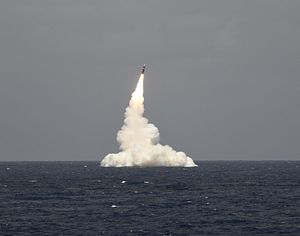The Ohio-class nuclear-powered ballistic missile submarine (SSBN), USS Rhode Island, test-fired an unarmed Trident II D5 ballistic missile from a submerged position off the coast of Florida on May 9, the U.S. Navy said in a statement. The test was overseen by the service’s Strategic Systems Programs (SSP).
The test firing of the submarine-launched Trident II D5 ballistic missiles (SLBM) was conducted as part of a so-called Demonstration and Shakedown Operation (DASO), designated DASO 29, and constitutes the 172nd successful test flight of the Trident II D5 missile since its introduction to the fleet in 1989, according to the Navy.
“The primary objective of a DASO is to evaluate and demonstrate the readiness of the SSBN’s strategic weapon system and crew before operational deployment following its engineered refueling overhaul (ERO),” the service said in a statement.
The Navy did not provide additional details regarding the Trident II D5 SLBM test. The USS Rhode Island completed its ERO in August 2018 during which the boomer has been refueled and upgraded, which extended the service life of the submarine for more than 20 years.
“USS Rhode Island’s successful test flight today demonstrates not only that this ship’s crew and shipboard weapons system are ready to return to service, but also that the sea-based leg of our nuclear deterrent remains ready, reliable and credible,” said Captain Mark Behning, the deputy director of SSP.
“While we’ve demonstrated today that our efforts to extend the life of our existing D5 missiles and SSBNs are successful, it is imperative that we remain focused on the Navy’s number one priority: on-time delivery of the first Colombia-class submarine,” Behning added.
The Columbia-class SSBN will begin replacing the Ohio-class in 2031. The U.S. Navy is currently operating 14 Ohio-class SSBNs, each capable of carrying up to 24 Trident II D-5 submarine-launched ballistic missiles. The Navy plans for a fleet of 12 Columbia-class boomers. The new class of SSBNs is designed for a 42-year service life all the way through 2085.
The Trident II D5 is a three-stage, solid propellant ballistic missile with a range of about 4,000 nautical miles or around 7,400 kilometers. The missile is fitted with multiple independently targetable reentry vehicles each carrying a thermonuclear warhead. housing the warhead.
According to the Bulletin of the Atomic Scientists: “The Trident D5s carry three types of warheads: the 100-kiloton W76/Mk-4, the 100-kiloton W76-1/Mk-4A, and the 455-kiloton W88/Mk-5 warhead, the highest-yield ballistic missile warhead in the U.S. arsenal.”
As my colleague Ankit Panda noted earlier this year, the U.S. has started production of a new low-yield nuclear warhead, designated W-76 2, for its Trident D5 SLBMs in 2019. “[T]the W76-2 is thought to be a primary-only version of the original W76, reducing its yield to the single-digit kiloton range,” he explained.
The USS Rhode Island, assigned to Submarine Group 10, is one of five SSBNs homeported at Naval Submarine Base Kings Bay, Georgia.

































